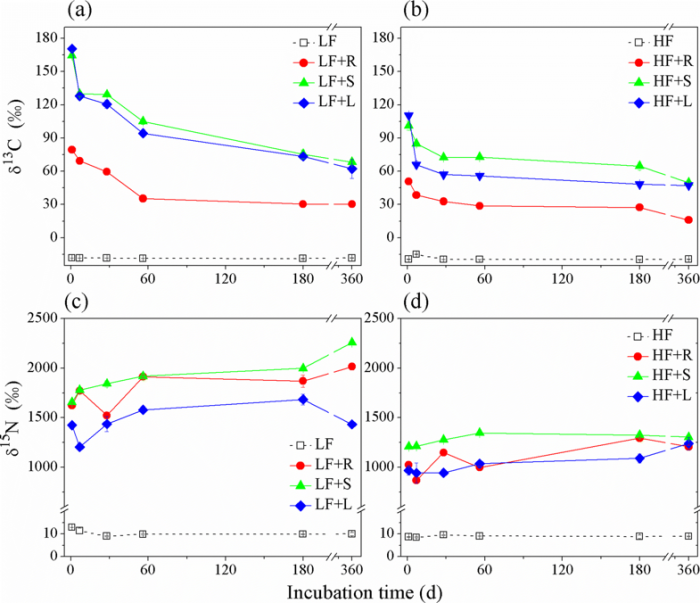秸秆还田是一种常见的农田措施。秸秆还田会向土壤中增加有机物,可能会增加土壤有机碳;但另一方面,秸秆还田可能加快土壤有机碳的分解(激发效应),而降低土壤有机碳。这些过程可能因土壤肥力和秸秆类型而异。因此,研究土壤肥力和秸秆残体类型对秸秆碳和土壤有机碳的分解的影响,对理解秸秆还田后土壤碳的收支过程至关重要。本研究将13C标记的玉米根、茎、叶分别添加到两种肥力不同的土壤中,经过360天的室内培养,周期性地测定土壤中13C同位素含量。我们发现,培养一年时间,低肥力土壤中玉米残体碳的矿化量要大于高肥力土壤,但在不同类型的残体之间没有差异。在高肥力土壤中,添加根、茎、叶在培养初期对土壤有机碳都表现为负激发效应,而在培养后期表现为正激发效应。而在低肥力土壤中,添加根、茎、叶没有表现出显著的激发效应。并且,360天培养后,总的激发效应在根、茎、叶之间没有显著差异。此外,高肥力土壤中,残体碳和土壤老碳总的分解量是低肥力土壤的1.4倍。综上所述,土壤肥力对植物残体碳和土壤老碳的分解受的影响要大于残体类型的影响。研究结果于2018年8月发表在SCI杂志Journal of Soils and Sediments上。论文第一作者为沈阳农业大学的徐英德博士生,通讯作者是沈阳农业大学的丁凡和汪景宽教授。
Fig. 1 Temporal change in δ13C and δ15N values in the treatments of low (a, c) and high fertility (b, d) soils amended with residues. LF low fertility soil (control), LF + R low fertility soil + root, LF + S low fertility soil + stem, LF + L low fertility soil + leaf, HF high fertility soil (control), HF + R high fertility soil + root, HF + S high fertility soil + stem, HF + L high fertility soil + leaf. Error bars are standard errors (n = 3)
Fig. 2 The proportion of residue C mineralization relative to the initial added residue C in the low (a) and high (b) fertility soils. LF low fertility soil (control), LF + R low fertility soil + root, LF + S low fertility soil + stem, LF + L low fertility soil + leaf, HF high fertility soil (control), HF + R high fertility soil + root, HF + S high fertility soil + stem, HF + L high fertility soil + leaf. Error bars are standard errors (n = 3)
论文全文请见:https://link.springer.com/article/10.1007/s11368-018-2152-7#Sec7
论文免费下载https://www.labxing.com/pdf.js/web/viewer.html?file=/files/lab_publications/3982-1634890165-eLMhxJzE.pdf


